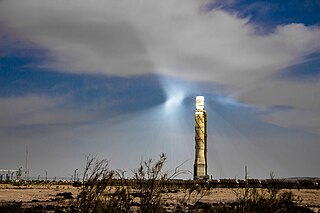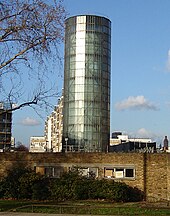
A power station, also referred to as a power plant or powerhouse and sometimes generating station or generating plant, is an industrial facility for the generation of electric power. Most power stations contain one or more generators, a rotating machine that converts mechanical power into electrical power. The relative motion between a magnetic field and a conductor creates an electrical current. The energy source harnessed to turn the generator varies widely. Most power stations in the world burn fossil fuels such as coal, oil, and natural gas to generate electricity. Others use nuclear power, but there is an increasing use of cleaner renewable sources such as solar, wind, wave and hydroelectric.

Bankside Power Station is a decommissioned electricity generating station located on the south bank of the River Thames, in the Bankside area of the Borough of Southwark, London. It generated electricity from 1891 to 1981. It was also used as a training base for apprenticeships from all over the country. It trained both craft and engineering students using specialised machine shops for the training. Since 2000 the building has been used to house the Tate Modern art museum and gallery.

Solar thermal energy (STE) is a form of energy and a technology for harnessing solar energy to generate thermal energy or electrical energy for use in industry, and in the residential and commercial sectors.

In electric power generation a combined cycle power plant is an assembly of heat engines that work in tandem from the same source of heat, converting it into mechanical energy, which in turn usually drives electrical generators. The principle is that after completing its cycle, the temperature of the working fluid in the system is still high enough that a second subsequent heat engine extracts energy from the heat that the first engine produced. By combining these multiple streams of work upon a single mechanical shaft turning an electric generator, the overall net efficiency of the system may be increased by 50–60%. That is, from an overall efficiency of say 34%, to possibly an overall efficiency of 62%, 84% Theoretical efficiency

A fossil fuel power station is a thermal power station which burns a fossil fuel such as coal, natural gas, or petroleum to produce electricity. Central station fossil fuel power plants are designed on a large scale for continuous operation. In many countries, such plants provide most of the electrical energy used. Fossil fuel power stations have machinery to convert the heat energy of combustion into mechanical energy, which then operates an electrical generator. The prime mover may be a steam turbine, a gas turbine or, in small plants, a reciprocating internal combustion engine. All plants use the energy extracted from expanding gas, either steam or combustion gases. Although different energy conversion methods exist, all thermal power station conversion methods have efficiency limited by the Carnot efficiency and therefore produce waste heat.

A thermal power station is a power station in which heat energy is converted to electric power. In most of the places in the world the turbine is steam-driven. Water is heated, turns into steam and spins a steam turbine which drives an electrical generator. After it passes through the turbine, the steam is condensed in a condenser and recycled to where it was heated; this is known as a Rankine cycle. The greatest variation in the design of thermal power stations is due to the different heat sources; fossil fuel dominates here, although nuclear heat energy and solar heat energy are also used. Some prefer to use the term energy center because such facilities convert forms of heat energy into electrical energy. Certain thermal power stations are also designed to produce heat energy for industrial purposes, or district heating, or desalination of water, in addition to generating electrical power.

The Bielsko-Biała Power Plant is a complex of coal-fired combined heat and power plants at Czechowice-Dziedzice near Bielsko-Biała, Poland. It has two principal flue gas stacks, 100 metres (330 ft) and 225 metres (738 ft) high, the latter of which is one of the tallest free standing structures in Poland. The complex is operated by Południowy Koncern Energetyczny, a subsidiary of the Tauron Group.

The Dürnrohr power station is a thermal power station in Lower Austria.

The Wilton power station refers to a series of coal, oil, gas and biomass fired CHP power stations which provide electricity and heat for the Wilton International Complex, with excess electricity being sold to the National Grid. It is located on the Wilton site in Redcar and Cleveland, south of the town of Middlesbrough in North East England. The station has provided for the site since opening in 1952, when it was operated by ICI. The station is currently owned and operated by SembCorp Industries.

Churchill Gardens is a large housing estate in the Pimlico area of Westminster, London. The estate was developed between 1946 and 1962 to a design by the architects Powell and Moya, replacing Victorian terraced houses extensively damaged during the Blitz.

Energy in Croatia describes energy and electricity production, consumption and import in Croatia.

The Ashalim power station is a solar power station in the Negev desert near the kibbutz of Ashalim, in Israel. It has the tallest solar power tower in the world at a height of 260 meters including the boiler, concentrating 50,600 computer-controlled heliostats.

The Rijeka Thermal Power Station is an oil-fired power station east of Rijeka at Kostrena, Croatia. It was built between 1974 and 1978 and it has one generation unit with capacity of 320 MW. The height of the boiler house including its rooftop flue gas stack is 250 metres (820 ft).

Viborg Power Station is a natural gas-fired power station operated by Energi Viborg in Viborg, Denmark.

Solar power in Denmark contributes to a goal to use 100% renewable energy by 2050. The goal of 200 MW of photovoltaics by 2020 was reached eight years early, in 2012, and 36 MW was being installed each month. Denmark had 790 MW in late 2015. A total of 3,400 MW is expected to be installed by 2030. Many solar-thermal district heating plants exist and are planned in Denmark.

The Southampton District Energy Scheme is a district heating and cooling system in Southampton, United Kingdom. The system is owned and operated by ENGIE.
Denmark is a world leading country in wind energy production and wind turbine production. In 2014 Denmark produced 57.4% of its net electricity generation from renewable energy sources. The Danish wind company Vestas Wind Systems A/S has expanded from its domestic base and by 2015 had a revenue of €8.423 billion, with more than 18,000 employees globally and manufacturing plants in Denmark, Germany, India, Italy, Romania, the United Kingdom, Spain, Sweden, Norway, Australia, China, and the United States. Wind power alone produced 42.7% of Denmark's electricity production in 2014 and is expected to increase its production by nearly 80% in the years to 2024.























